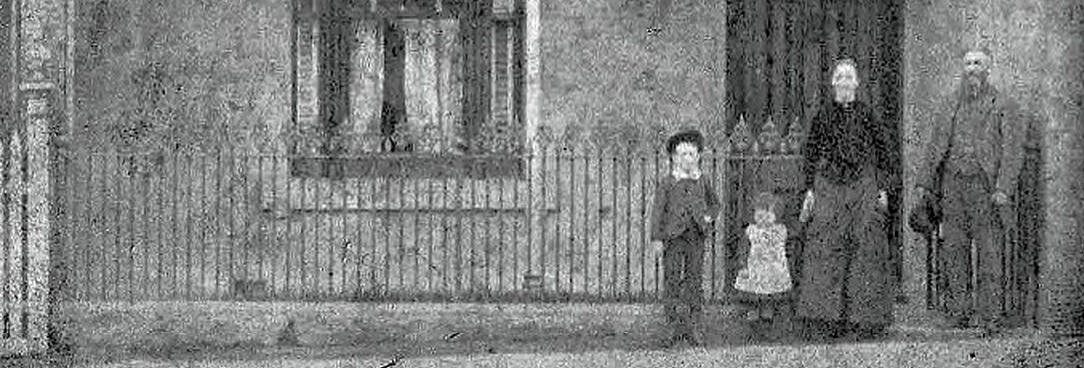Last updated:
‘John Jones: a builder of early West Melbourne’, Provenance: The Journal of Public Record Office Victoria, issue no. 14, 2015. ISSN 1832-2522. Copyright © David Evans
This paper gives an account of the life and work of John Jones (1836–1909), a Welshman who plied his skills as a stonemason and builder in inner Melbourne during the latter half of the nineteenth century. During his working life, Jones built over 40 homes, predominantly in West Melbourne, including his family home in Hawke Street. Primary historical records available at Public Record Office Victoria have been used to trace the surviving homes built by Jones and to map their location. The earliest surviving property is a simple brick and stone cottage in Hawke Street constructed in 1873. More recent properties built between 1877 and 1889 were generally larger two-storey residences characteristic of the late Victorian era. In his last major project in 1892, John Jones was one of two contractors to build St David’s Hall at the rear of the Welsh Church in La Trobe Street, Melbourne. The hall has served the Welsh Church community in Melbourne for over 120 years and in the 1890s was used as a medical clinic for women, which later evolved into the Queen Victoria Hospital.
North Melbourne and West Melbourne have developed in parallel, with the first major building in the area being the Melbourne Benevolent Asylum, which opened in 1851.[1] Situated in bushland at the western end of Victoria Street, the asylum straddled the boundary of both suburbs and became the area’s dominant landmark during the nineteenth century. The sale of town allotments to accommodate the rapidly growing population quickly followed and within 20 years both North Melbourne and West Melbourne had significant areas of residential development. In West Melbourne the residential area was confined to the north-western fringe of the city and consisted of a mix of worker’s cottages and larger two-storey row houses. Industries were also attracted to the area, particularly after the draining of the West Melbourne swamp in 1879, and over time encroached into the residential area.[2] Further commercial development in the latter part of the nineteenth and early twentieth centuries resulted in the displacement of much of the early housing stock so that by the late 1970s only small pockets of the original housing remained. However, it was not until the 1980s that the heritage value of the surviving homes was recognised and efforts made to record and conserve the surviving historic properties.[3]
There were a great many builders active in West Melbourne during the nineteenth century but the name of John Jones is one that keeps re-occurring in the historical records. He was a particularly industrious builder with over forty homes to his credit and at least another six in partnership with his cousin, David Hughes. The vast majority of Jones’s work was in West Melbourne where he lived with his family from the 1860s until his death in 1909.
This paper gives a brief history of John Jones’s life and work. Primary historical records have been used to trace the surviving homes in West Melbourne and to map their location and some of their early occupants. His role in the construction of St David’s Hall at the rear of the Welsh Church in La Trobe Street, Melbourne is also described and the importance of this hall to the establishment of the Queen Victorian Hospital is highlighted.
Early years
John Jones (see figure 1) was born on 26 March 1836 in the village of Pantperthog in North Wales.[4] His father died when he was very young and the family relocated to the nearby village of Corris. At the age of 16, Jones was working as a fuller in one of the local woollen mills.[5] It is unclear how long Jones remained at the mill but according to a surviving diary written in his native tongue we learn that by 1855 at the age of 19 he was working as a stonemason in the district of Corris.[6]
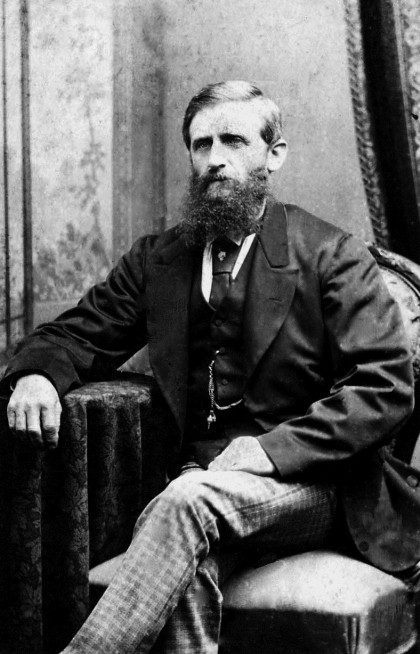
In 1856, Jones and several of his friends and colleagues decided to emigrate to Australia where his uncle, John Hughes and cousin David Hughes were establishing themselves as builders in Portland and Parkville respectively. It was with David Hughes that Jones would later join in partnership to build a number of homes in inner Melbourne.
Jones left Wales on Thursday 17 April 1856 and sailed from Liverpool on theMindoro on 22 April.[7] He arrived at Sandridge (Port Melbourne) on Sunday 13 July, a journey of eleven weeks and six days. After several months in Melbourne, Jones moved to Portland where he teamed with his uncle, John Hughes, who was working in the town as a stonemason.[8] Hughes has a number of fine buildings to his credit in Portland including Customs House (1849–50) and Burswood (1855–56), the mansion of Edward Henty, Portland’s first permanent settler.[9] It is highly likely that the young Jones contributed to a number of Portland’s early buildings while working with Hughes but it should be noted that many early buildings attributed to John Jones in Portland in the 1850s are those of another stonemason with the same name.[10]
After approximately two and a half years in Portland, Jones returned to Melbourne where it appears he commenced building in his own right. Two notices of intention to build under his name were lodged in 1858; the first for a workshop in Grimes Lane, Melbourne on 30 June 1858 and the second for a store in Gore Street, Fitzroy on 1 October 1858.[11] Around 1859, Jones was struck with gold fever and set off for the Chiltern and Beechworth diggings to try his luck.[12] He appears to have had some success since he reported trouble with gold thieves and was even stabbed, although fortunately not seriously. It is not known when Jones returned to Melbourne but it is likely that prior to 1867 he was engaged in small scale alterations and additions in Melbourne that have not been captured in the records.
In 1867, Jones lodged an application to build two cottages for himself in Hawke Street, West Melbourne near the corner of Spencer Street.[13] It is believed that these houses were located at 40 and 42 Hawke Street, near the corner of Dicks Place, and although they have not survived, they appear to be the first houses built by Jones in West Melbourne, marking the beginning of his long career as a house builder in the neighbourhood.
Tracing John Jones’s buildings
In Melbourne after 1850, builders were required to lodge a notice of intention to build with the council and pay the prescribed fee before commencing work. An index of these applications, arranged in chronological order, was compiled by the late Winston Burchett of the University of Melbourne’s School of Architecture. This index (now called the Burchett Index) is available on microfiche at Public Record Office Victoria (PROV) and is a key resource for identifying the location, construction date, architect and the name of the contractor for early buildings in Melbourne. In 2013, entries in the Burchett Index were incorporated into a searchable database within the Australian Architectural Index.[14]
The methodology used for tracing the homes built by John Jones initially involved a search of the Burchett Index for notices lodged by Jones between 1856 and 1909. Over 40 notices were found, most of which are for properties located in West Melbourne. Unfortunately, these notices do not uniquely locate a property because the situation was described in terms of the street name, the block as defined by the nearest cross-streets (in most but not all cases) and the side of the street (north, south, and so on). Street numbers were rarely given and if used were unreliable before 1889 when street numbering in West Melbourne was standardised.[15] Thus in order to unambiguously locate a property, additional primary records including rate books, directories and land title records must be consulted.
Rate books for the City of Melbourne are available at PROV on microfiche and give details of rated properties including the owner’s name, occupier, the size of the land and details of the building including the number of rooms, type of construction and the rates levied.[16] By scanning forward through the rate books over consecutive years around the time of construction it is possible to see a property appear for the first time. The name of the occupant in the rate book should correlate with the occupier in the Sands and McDougall’s Melbourne and suburban directory and can provide a useful marker for a house.[17] The details of neighbouring properties (occupants, owners and property details) are also useful markers but it must be remembered that adjacent entries in the rate books are not necessarily neighbouring properties because before 1880 vacant land was not listed. By following a house forward through the rate books and the directories until street numbers are reliable it is generally possible to determine the address of a property. Finally, land titles show the history of ownership of a piece of land and its location, and as legal documents, are highly reliable. They are particularly valuable in eliminating ambiguities that may arise from other primary sources but importantly they relate to the land only and on their own cannot provide a construction date for a heritage property.
Consultation of the original notices of intention to build contained within VPRS 9288 is also important since occasionally it provides additional information that has not been captured in the Burchett Index. For example, according to the 1879 listings in the Burchett Index, Jones, working in partnership with his cousin David Hughes, lodged a notice to build a six-room two-storey house on the north side of Roden Street between Spencer and King streets for T Bowden.[18] The original notice as shown in figure 2 has the additional comment ‘same sort as Mr Coopers [sic] next door’. This comment was helpful in locating the house since some 18 months earlier on 30 August 1877, Jones gave notice to build a five room house on the north side of Roden Street for Alfred Cooper (see figure 3).[19] Thomas Bowden owned several houses in Roden Street but Alfred Cooper had only one so by cross-referencing with the rate books it was not only possible to locate these neighbouring properties but also to confirm their dates of construction. References to the notices of intention to build in this paper are to the primary records contained within VPRS 9288.
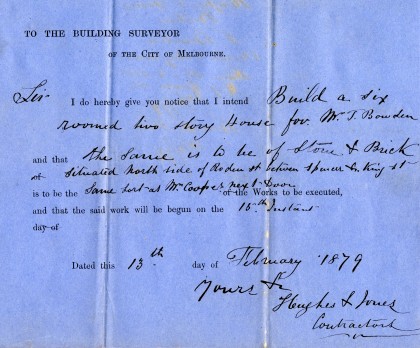
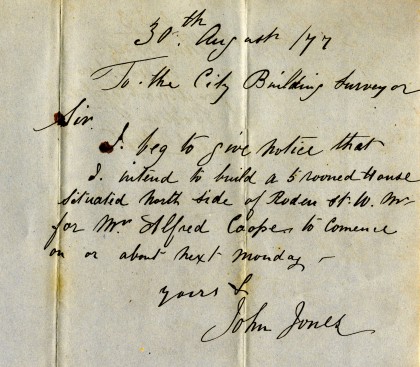
An important secondary source of information on heritage properties in the City of Melbourne is Graeme Butler’s, North and West Melbourne Conservation Study undertaken for the City of Melbourne in 1983.[20] This study gives architectural details of each property together with a photograph and in selected cases historical information on builders, early owners and tenants. More recently, properties listed in Butler’s study have been incorporated into the City of Melbourne’s online database of heritage places (i-Heritage).[21]
Using the above resources it has been possible to identify, with a high level of confidence, all of the surviving homes built by Jones in the West Melbourne region. An index of all properties for which Jones gave a notice of intention to build has been compiled but in a number of cases their exact location has not been unambiguously identified.[22]
Jones’s properties (1873–1889)
Jones constructed over 40 homes in inner Melbourne between 1867 and 1892. A number of these homes were built for specific clients but many were self-funded and sold only on completion. With the exception of St David’s Hall (see below), Jones did not use an architect for any of his projects although he did use the same decoration to the façades and party walls particularly for homes built during the latter part of his career.
Table 1 summarises the surviving homes built by Jones and shows the registration number used by the City of Melbourne, the current address of each property and the original owner or tenant. With the exception of the house in Fitzgibbon Street, Parkville, all of the surviving homes are situated in Roden, Hawke or Adderley Streets, West Melbourne and their locations are shown in figure 4.
Table 1. Surviving properties built by John Jones between 1873 and 1892.
|
No.1 |
Date |
Details as per notice of intention to build |
Address of property |
Built for or owner |
Occupier |
|
5267 |
21 Feb 1873 |
Hawke St, below Adderley two-room brick cottage |
112 Hawke St |
D Davies |
D Davies |
|
5883
|
9 May 1874 |
Adderley St, situated near corner of Roden St – cottage |
179 Adderley St |
J Clarke |
|
|
5983 |
23 Jul 1874 |
Hawke St, between Spencer & Ireland streets – two cottages |
44 Hawke St 46 Hawke St |
J Jones J Jones |
J Burrage W McKnight |
|
6199 |
19 Jan 1875 |
Hawke St, north-west side – two-room brick & stone cottage |
114 Hawke St |
I Williams |
I Williams |
|
7147 |
4 Apr 1877 |
Roden St, north side between Spencer and Adderley streets – two-storey, five-room house |
148 Roden St |
J Stokes |
J Stokes |
|
7179 |
3 May 1877 |
Roden St, between Spencer and Adderley streets – six-room, two-storey house |
152 Roden St |
A Hulme |
A Hulme |
|
7333 |
30 Aug 1877 |
Roden St, north side – five-room house |
82 Roden St |
A Cooper |
A Cooper |
|
7584 |
13 Apr 1878 |
Parkville, Fitzgibbon St – brick cottage with parapet |
59 Fitzgibbon St, Parkville2 |
G McAdam |
G McAdam
|
|
7904 |
13 Feb 1879 |
Roden St, north side between Spencer and King streets – six-room two-storey house. ‘Same sort as Mr Coopers next door’. |
80 Roden St2 |
T Bowden |
T Bowden |
|
8040 |
14 Jul 1879 |
Hawke St, between Ireland and Adderley streets – two brick and stone houses |
76 Hawke St 78 Hawke St |
J Jones |
G Pitkethly H Tait |
|
8457 |
4 Aug 1880 |
Hawke St, near Adderley St – stone and brick house |
80 Hawke St |
J Jones |
T Easton |
|
8842 |
7 Jul 1881 |
Hawke St, north side between Adderley and Ireland streets – six-room house |
‘Bodiwan’, 74 Hawke St |
J Jones |
J Jones & family |
|
9350 |
5 Sep 1882 |
Adderley St, north west of Hawke St – brick house with slate and iron roof |
220 Adderley St |
W Clarke |
W Clarke |
|
181
|
17 Feb 1883 |
Adderley St, north side of Hawke streets – two-storey brick house |
218 Adderley St |
J Proud |
J Proud |
|
503 |
24 Sep 1883 |
Roden St, north side between King and Spencer streets – two two-storey houses |
92 Roden St 94 Roden St |
J Jones Jones/Evan Roberts |
R Moore E Roberts |
|
1188 |
12 Nov 1884 |
Adderley St, rear of Mr Proud’s dwelling, first house north side of Hawke St – workshop |
218A Adderley St |
J Jones’s workshop & stable |
J Jones |
|
2756
|
28 Apr 1887 |
Adderley St, near Roslyn St – brick and stone two-storey house |
‘Corris’, 136 Adderley St |
J Jones |
R Jones |
|
3810
|
8 Mar 1889 |
Hawke St, south side opposite Ireland St – two-storey house |
131 Hawke St |
F Fewster |
F Fewster
|
|
5549
|
23 Jul 1892 |
La Trobe St West – classrooms and hall at rear of church |
La Trobe St, Melbourne |
Welsh Church Trustees |
Notes to Table 1:
- Registration number used on the notice of intention to build
- Built by Hughes and Jones
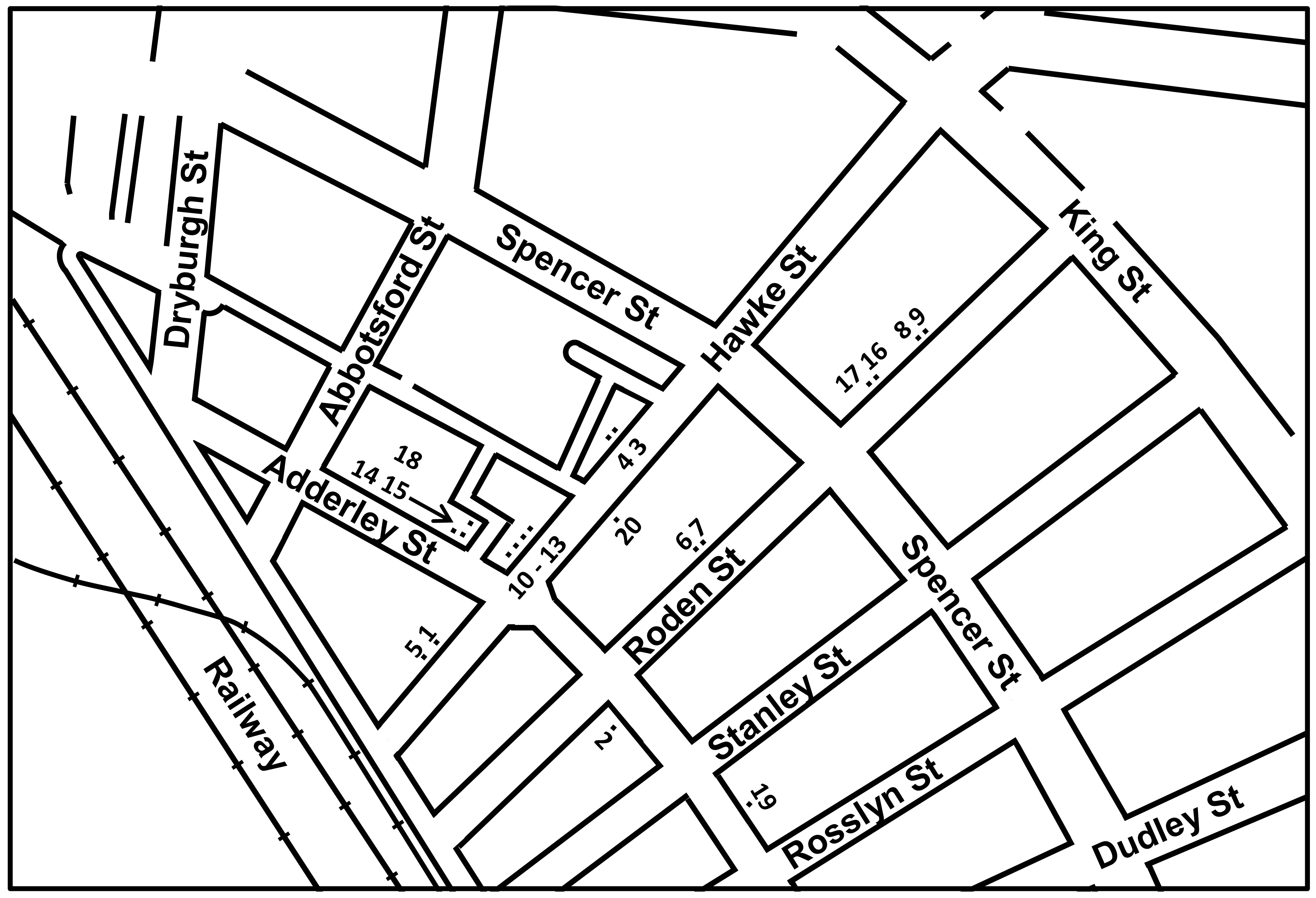
Key to map
|
No. on map |
Current street number |
Build date |
|
1 |
112 Hawke Street |
1873 |
|
2 |
179 Adderley Street |
1874 |
|
3 |
44 Hawke Street |
1874 |
|
4 |
46 Hawke Street |
1874 |
|
5 |
114 Hawke Street |
1875 |
|
6 |
148 Roden Street |
1877 |
|
7 |
152 Roden Street |
1877 |
|
8 |
82 Roden Street |
1877 |
|
9 |
80 Roden Street |
1879 |
|
10 |
76 Hawke Street |
1879 |
|
11 |
78 Hawke Street |
1879 |
|
12 |
80 Hawke Street |
1880 |
|
13 |
74 Hawke Street |
1881 |
|
14 |
220 Adderley Street |
1882 |
|
15 |
218 Adderley Street |
1883 |
|
16 |
92 Roden Street |
1884 |
|
17 |
94 Roden Street |
1884 |
|
18 |
218A Adderley Street |
1884 |
|
19 |
136 Adderley Street |
1887 |
|
20 |
131 Hawke Street |
1889 |
A study of the owners and occupants of houses built by Jones during the late nineteenth and early twentieth centuries gives a glimpse of the early population of West Melbourne. From a scan of the rate books and the Sands and McDougall directories it is apparent that many of the homes were leased with a significant number of these changing hands frequently. This indicates a very mobile society possibly in response to the changing nature of the suburb from one that was almost exclusively residential in the 1880s to a mixed use in the first half of the twentieth century. Major employers of these residents included the Victorian Railways, the shipping industry and associated Victoria Dock and the Metropolitan Gas Company (forerunner of the Gas and Fuel Corporation).
Long-term residents employed by the Victorian Railways in the late 1800s include, Fred Fewster (131 Hawke Street) who was in the Transportation Branch, Thomas Bowden (80 Roden Street) who was described as a railway official and Alfred Cooper (82 Roden Street) who worked as a rolling stock inspector.[23] Another employee of the Victorian Railways was William Hulme of 152 Roden Street. His son, Andrew Hulme, a tailer based in Elizabeth Street and later Little Collins Street continued to live in the house following the death of his father in 1904.[24]
Captain George Pitkethly, who purchased 76 Hawke Street from Jones in August 1880 for £530, was master of the barque Kate Tatham and later theEarn. He was Master of the latter vessel when he died at sea off King Island in 1889.[25] During the last 9 years of his life he alternately occupied and leased his property to such people as boot retailers William Leeming and Pat Morgan.[26] Leeming was the proprietor of the Colonnade Boot Bazaar located at 1 Errol Street, North Melbourne.[27]
A number of other residents of Jones’s houses worked in the manufacturing industry. These included, Joshua Proud of 218 Adderley Street who was a manufacturer of blacking and charcoal, and Thomas Easton of 80 Hawke Street, who was employed by the Victorian Iron Rolling Company located in Dudley Street, West Melbourne.[28] The Tait family were the owners and occupiers of 76 Hawke Street from 1880 until 1917. Mr Tait was a foreman with the Metropolitan Gas Company for 27 years and died in August 1890.[29] He was survived by his wife, Agnes, a music teacher who continued to live at number 76 for many years.[30]
Another person of interest to live in a house built by Jones was Phillip Pedretti, a World War I veteran who resided with his family at 46 Hawke Street from 1943 until the late 1960s.[31] Phillip Pedretti was originally a miner from Dry Diggings near Daylesford and enlisted with the first Australian Imperial Force in Melbourne in 1916.[32] He served with the Third Pioneers and was taken on strength in France in December 1916. He was hospitalised several times during 1917–18 and received treatment for shell shock in England before returning home in March 1919.[33] After the war Phillip Pedretti found work as a driver.
The survival rate of houses built by Jones is less than 50% and has been severely impacted by past planning decisions. For example, a 1954 proposal to build an inner city ring road by the Melbourne Metropolitan Board of Works required the widening of Hawke Street through public acquisition of properties on the north-western side of the street (see figure 5).[34] The scheme was later abandoned but it was too late to save up to nine terrace homes including at least five built by Jones.
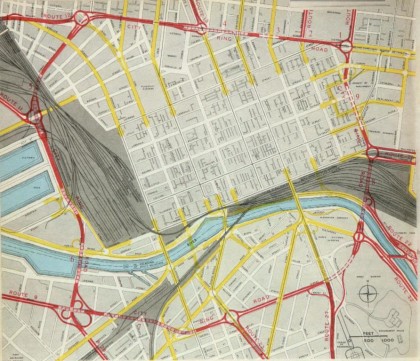
The oldest surviving home built by Jones is the cottage at 112 Hawke Street built for carpenter, David Davies in 1873 (see figure 6). Land title data shows that Davies officially purchased the land from George Baker on 4 March 1873, two weeks after Jones lodged a notice of intention to build a two-room brick cottage for Davies on 21 February 1873.[35] The house with David Davies as owner and occupier first appears in the rate books in 1874, clearly dating the cottage to between 1873 and early 1874.[36] The house is a typical single-fronted worker’s cottage with original wrought iron fence, veranda decoration and roof structure. The addition of the parapet orbs is clearly out of character and suggests a later addition. David Davies lived in the house for approximately eleven years before selling it to George Hill in 1885.[37] The adjacent property at 114 Hawke Street (see figure 6) was also built by Jones in 1875, approximately one year after the completion of its neighbour.[38] It was built for fireman Isaac Williams who also purchased this allotment from George Baker in 1874 and resided there with his wife until his death in 1898.[39]
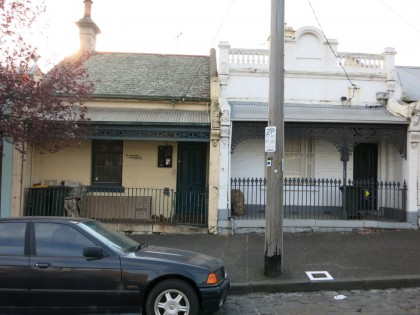
Another early Jones cottage of similar design is that at 179 Adderley Street, West Melbourne (see figure 7). Butler reported that this residence was built for John Clarke in 1889 at the same time as the corner shop at 181 Adderley Street.[40] However, land title data and a notice of intention to build lodged by Jones on 9 May 1874 clearly indicates that Jones built this house for John Clarke in 1874 on land that Jones had sold to Clarke two years previously.[41] The cottage is similar to those at 112 and 114 Hawke Street with a similar veranda, fence and roof structure.
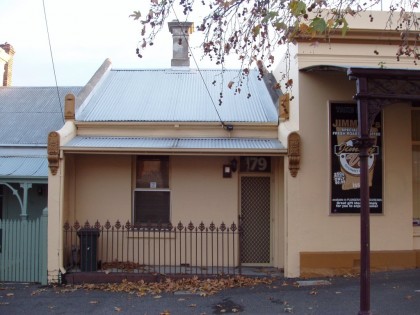
Houses built by Jones after 1877 were generally two-storey terraces of six or seven rooms. The highest concentration of such houses is in Hawke Street, between Ireland and Adderley streets. In 1885, there were seven of Jones’s terraces in this space although only four have survived. The original streetscape can be gauged from the photograph shown in figure 8 taken circa 1977. The four two-storey terraces on the right were built by Jones between 1879 and 1881 while the two, two-storey terraces on the extreme left were all that remained of a block of three, called Bala Terrace, constructed by Jones in 1885.[42] The single-storey cottage wedged between the two blocks of two-storey terraces is the oldest home in the block and was built by David Clarke for William Clarke in 1873.[43]
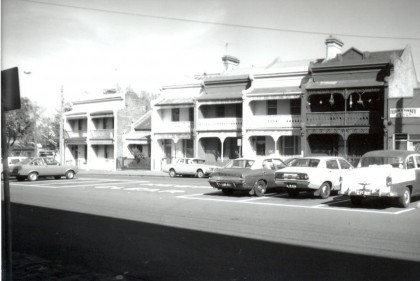
The same streetscape today (see figure 9) shows the four surviving terraces built by Jones between 1879 and 1881. Butler reported that this row is one of the few relatively original streetscapes in West Melbourne and is unusual since each house is set at an angle parallel with the side street (Ireland) rather than directly fronting Hawke Street.[44] This, together with the fact that they are the work of a local owner–builder adds to their local historical significance.
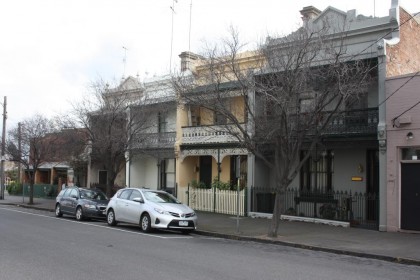
Each house features a two-storey veranda addressing the street from between the party walls. This style, generally known as Victorian filigree, is characteristic of much of the housing in the inner suburbs of Melbourne during the latter half of the nineteenth century. The extensive use of decorative ironwork is regarded as distinctly Australian, although comparable examples do exist in many other countries notably the United States (New Orleans), the West Indies and South Africa.[45] The major variation to the external façades of such houses was the decoration to the party walls and parapets, and builders tended to use the same features over and over again. Jones was no exception and for all his two-storey homes he used moulded figurehead plaques, lion heads and scrolled corbels on the party walls. Parapets appeared to be an optional extra and were generally plain.
The house at 74 Hawke Street (extreme right, figure 9) was the Jones family home. Jones lodged a notice of intention to build for this house on 7 July 1881 to accommodate his growing family.[46] He married Margaret Jones from Wales in the Welsh Church of Melbourne in 1874 and they had three children, Dafydd (born 1877), Elizabeth (born 1881), and Gwendolen (born 1883).[47] The house was named ‘Bodiwan’, sometimes spelt ‘Bod-iwan’, which is attributed to Margaret Jones after a stately home in Bala, North Wales, the town of her birth. Confirmation of the name, ‘Bodiwan’ comes from two sources.[48] Firstly, notices of intention to build submitted by Jones after 1881 were signed ‘John Jones, Bodiwan, Hawke Street’ and secondly, from a petition submitted to the City of Melbourne by West Melbourne residents in 1887.[49] This petition requested the reinstatement of the hackney carriage stand to the corner of Hawke and Spencer streets, and because it pre-dates the standardisation of house numbers in West Melbourne, residents often gave their address using their street and house name (see figure 10). Such petitions are a wonderful resource for local historians searching for original names of old houses in the neighbourhood.
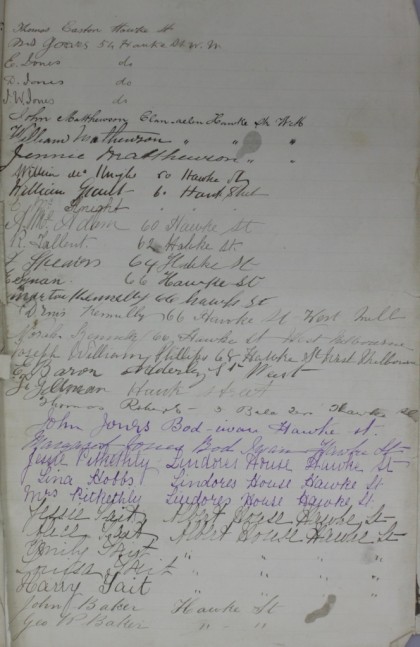
Photographs of the Jones family home circa 1884 and 130 years later in 2014 are shown in figure 11. The people standing at the front gate of the house in the early photograph are John and Margaret Jones and their two eldest children, Daffyd and Elizabeth Jones. The identities of the people on the first floor veranda are unknown.
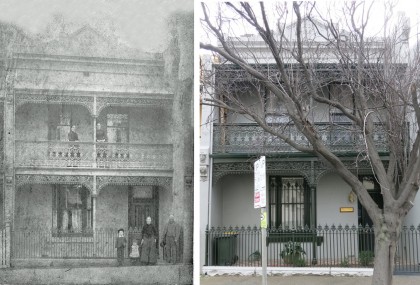
Jones went to considerable effort to distinguish Bodiwan from its neighbours.[50] For example, it has a scrolled parapet above its cornice contrasting with the plain parapets of 76 and 78 Hawke Street. He also installed a wrought iron fence and used a classic Victorian pattern for the encaustic tiles for the front veranda. The allotment is also significantly wider than the others in the street although the original land title specified each allotment as 18 feet in width.[51] As owner and builder of the adjacent homes Jones clearly became aware of a hiatus of almost three feet in the dimensions of the original survey and commandeered this extra width for himself. The error in the original survey was not corrected until a new certificate of title was issued in 2002.[52]
Between 1882 and 1889, Jones was active in building at least 15 houses in the West Melbourne area although only seven of these have survived to the present day. Particularly good examples are those at 92 and 94 Roden Street (shown in figure 12). Jones formerly purchased an allotment with a 40 foot frontage between Spencer and King streets from John Alison on 15 October 1883 after making an application to build two two-storey houses on this land on 24 September 1883.[53] The properties first appear in the rate books in 1884 consistent with the date ‘AD 1884’ moulded into the parapets. After subdivision, Jones sold these houses to Evan Roberts (92) and Richard Moore (94).[54]
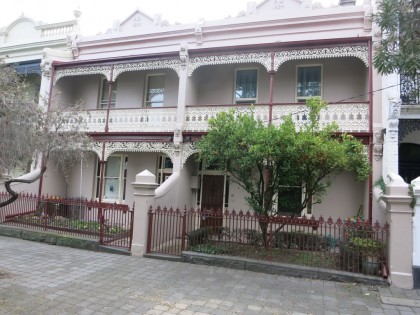
Another fine example of a late Jones house is located at 136 Adderley Street (see figure 13). The notice of intention to build was lodged on 28 April 1887 again consistent with the date ‘AD 1887’ moulded into the parapet.[55] The house was named ‘Corris’ after the nearest town to his birthplace in Gwynedd, North Wales and was initially occupied by Robert Jones and later by JJ Owen, minister of the Melbourne Welsh Church.
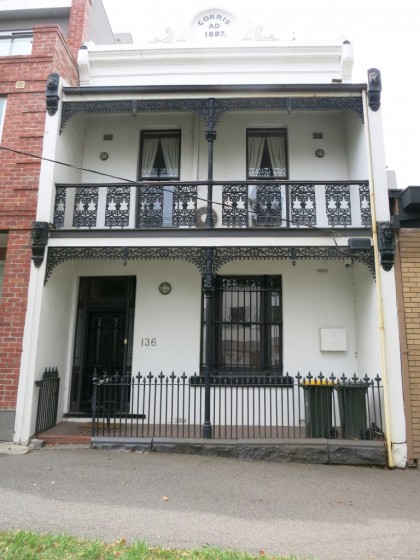
With the depression of the 1890s, demand for new homes dried up and after 1889 Jones did not construct any new homes. His last home, which has not survived, was for a ‘dwelling house of stone and bricks’ for Isaac Williams in Dudley Street in 1889.[56] After this time, Jones continued smaller-scale work variously described in the records as ‘additions’ or ‘reinstatements’ largely to his own properties.
St David’s Hall, Melbourne Welsh Church (completed 1893)
The last major construction by John Jones was a project undertaken for the Melbourne Welsh Church in 1891–92. The church, of which Jones was treasurer for 22 years, had need for a hall and rooms for a Sunday school and other social occasions.[57] Plans for the buildings were prepared by architects SWL Powell and to keep costs to an acceptable figure, the church acted as builder using John Jones and Robert Jones, two experienced builders from the congregation, to undertake the project using day labour.[58] With strong patriotic spirit, the church elders instructed the builders to ‘hire Welsh tradesmen where possible.’ The hall, shown in figure 14 was built for a total cost of ₤815.1.9 and was used for the first time on the first of March 1893 (St David’s Day) and is appropriately known as St David’s Hall.
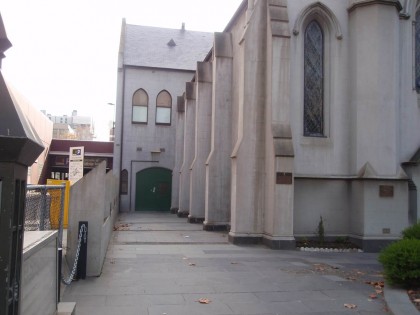
St David’s Hall has been a popular venue for meetings and celebrations of the Welsh Community in Melbourne and has been used for a wide variety of events including weddings, eisteddfods and meetings of the Cambrian Society. The society was established in 1872 and held regular meetings in the hall including the diamond jubilee of the society in 1932.[59]
Many weddings were celebrated in the hall. Typical of these was the wedding of Hilda Morton of North Melbourne to Henry Pinney of Moonee Ponds in June 1910.[60] Hilda was a member of the church congregation and a Sunday school teacher and following their marriage the couple celebrated their wedding breakfast in St David’s Hall. The Reverend JJW Owen, who later lived in the house built by Jones at 136 Adderley Street, West Melbourne, officiated at the wedding.
Prime Minister Mr Billy Hughes was one of many distinguished guests to be welcomed by the Welsh community in the hall.[61] This event in January 1916 celebrated Mr Hughes’s appointment as Prime Minister and farewelled him on his world travels in support of World War I efforts. Another distinguished guest entertained in the hall was Lord Mountevans, formerly Admiral ‘Teddy’ Evans, who in addition to being a distinguished British naval officer was second in command to Captain Robert Scott during the British Antarctic Expedition of 1910 to 1913.[62]
This story of John Jones’s building works would not be complete without mentioning the use of St David’s Hall in the 1890s as a medical day clinic for women.[63] The clinic was established by Dr Constance Stone, the first Australian woman to practice medicine in Australia. Dr Stone was working at Dr John Singleton’s Free Medical Mission in Collingwood in the early 1890s and saw a need for a separate medical clinic for disadvantaged women. Her husband was the Rev Dr David Egryn Jones, minister of the Welsh Church and also a doctor. Together in 1896 they persuaded the church elders to grant permission for Dr Stone to establish her clinic in St David’s Hall. Under Dr Stones’ supervision the clinic ran in the hall for a number of years and was staffed by two of the first female doctors to graduate in medicine from the University of Melbourne including her sister, Dr Clara Stone.
The clinic initiated by Dr Stone and her colleagues became the nucleus of the Queen Victoria Memorial Hospital which continues today as the Monash Medical Centre. A plaque commemorating Dr Stone’s work is mounted on the front of the church in La Trobe Street and a second plaque was mounted inside St David’s Hall on the 75th anniversary of the foundation of the hospital in September 1971. The church community have continued to support the hospital through fundraising for over 100 years helping to keep the legacy of Constance Stone and Egryn Jones alive.
Jones family history
Margaret Jones died at Bodiwan on 23 December 1891 at the age of 48.[64] John survived his wife by 25 years and died in Melbourne on 23 January 1909, aged 73.[65] At the time of his death John Jones owned 11 homes including the family home and these were left to his children as follows: numbers 44, 46, 62 and 64 Hawke Street to Gwenddolen Jones; 84, 86 and 88 Hawke Street to Elizabeth Jones; and 11 and 13 Ireland Street and the stable and workshop at the rear of 218 Adderley Street to David Jones.[66] Excluding the family home at 74 Hawke Street only three of these properties (44 and 46 Hawke Street and 218A Adderley Street) have survived to the present day.
The Jones family retained ownership of the family home for three successive generations with Gwenddolen Hughes (third child of John and Margaret Jones) taking ownership of the property from her siblings in 1914.[67] The Hughes family lived in Bodiwan raising their family of two boys, John and Evan, until it was sold in 1955, a continuous occupation by the Jones/Hughes family of 74 years.[68]
Acknowledgements
I am indebted to the late Mr Evan Hughes, grandson of John Jones, for his assistance during the writing of this work and for copies of documents relating to John Jones’s life. His assistance with the history of the Melbourne Welsh Church and St David’s Hall in particular was greatly appreciated. My thanks also to Margaret Grobb of the Portland Historical Society, Dr Karl Hessian for a preprint of his paper on the history of house numbering in inner Melbourne and to the staff at Public Record Office of Victoria for their assistance. I would also like to thank Allen Haines for digital restoration of the early photographs and Dr Jeff Church for drawing the map showing the location of Jones’s properties. Finally, my thanks to the members of Hotham History Project Inc. for their encouragement.
Endnotes
[1] Mary Kehoe, The Melbourne Benevolent Asylum, Hotham’s Premier Building, Hotham History Project, North Melbourne, 1998, p. 17.
[2] Albert Mattingley, ‘The Early History of North Melbourne’, Victorian Historical Society Magazine, Vol. V, No. 2, December 1916.
[3] Graeme Butler, North and West Melbourne: Conservation Study for the City of Melbourne of North and West Melbourne, Vols 1 and 2, Melbourne City Council, Melbourne, 1983.
[4] Anon., ‘Welsh Pioneers: John Jones’, Cambrian Society Magazine, April 1939, p. 12.
[5] 1851 Census of England and Wales, Parish of Pennal Upper, p. 194.
[6] Diary of John Jones, 1856, kindly made available by Evan Hughes and translated from Welsh by Elin Coleman, March 2000. Excerpts of John Jones’s diary have been published in Y Fanner, 10 May 2000.
[7] PROV, VPRS 7666 Inward Overseas Passenger Lists (British Ports) [Microfiche Copy of VPRS 947], Fiche 110, Mindoro, p. 9.
[8] Anon., ‘Welsh Pioneers’, p. 12.
[9] Gwen Bennett, Portland; Now and Then, A Guide to Portland’s Historic Buildings, Gwen Bennett, Portland, 1993, p. 13.
[10] ibid., pp. 2 and 10. Margaret Grobb, Secretary, Portland Historical Society, personal correspondence, 2013.
[11] PROV, VPRS 9288/P1 Notices of Intention to Build, Unit 6, No. 540, 30 June 1858, and No. 782, 1 October 1858.
[12] Anon., ‘Welsh Pioneers’, p. 12.
[13] PROV, VPRS 9288/P1, Unit 10, No. 1860, 31 January 1867.
[14] PROV, VPRS 9463/P3 Burchett Index: Notices of Intention to Build (Microfiche), Australian Architectural Index available at <http://www.mileslewis.net/australian-architectural.html>, accessed August 2013.
[15] Barbara Armstrong, ‘Beware the Street Number’, Ancestor, Vol. 31, No. 8, 2013, pp. 8–11.
[16] PROV, VPRS 5708/P2 Rate Books.
[17] Sands and McDougall’s Melbourne and suburban directory, Sands and McDougall, Melbourne, 1863–1901.
[18] PROV, VPRS 9463/P3, Unit 122, No. 7904, 14 February 1879.
[19] PROV VPRS 9288/P1, Unit 13, No. 7904, 14 February 1879, and No. 7333, 30 August 1877.
[20] Butler, North and West Melbourne: Conservation Study, Vols 1 and 2.
[21] City of Melbourne i-Heritage is available at <http://www.melbourne.vic.gov.au/buildingandplanning/planning/heritageplanning/Pages/iHeritage.aspx>, accessed April 2014.
[22] The index is available upon request from the author.
[23] Canberra Times, 16 January 1929, p. 4; Age, 12 October 1892, p. 7; Age, 3 August 1889, p. 1.
[24] Butler, North and West Melbourne Conservation Study, Vol. 1, p. 356;Argus, 1 August 1904, p. 1.
[25] Age, 12 March 1890, p. 4.
[26] Butler, North and West Melbourne Conservation Study, Vol. 1, p. 356.
[27] Butler, North and West Melbourne Conservation Study, Vol. 1, p. 269.
[28] Age, 5 May 1883, p. 2; Argus, 24 April 1906, p. 1.
[29] Argus, 6 August 1889, p. 1.
[30] Butler, North and West Melbourne Conservation Study, Vol. 1, p. 356.
[31] Ancestry.com copy of NAA, Electoral Rolls, CA 1854, 1906–1973, subdivision of Melbourne, Phillip Thomas Pedretti, 1943, No. 12568, p. 106; 1968, No. 4002, p. 35.
[32] First Australian Imperial Forces, Personnel dossiers, World War I Service Records, 1914–20, NAA: B2455, Pedretti Phillip Thomas, pp. 1–37.
[33] Ibid.
[34] EF Borrie, Melbourne Metropolitan Planning Scheme Report, Melbourne and Metropolitan Board of Works, Melbourne, 1954, p. 98.
[35] Victorian Office of Land and Titles, Certificate of Title, Vol. 325, Folio 64927, 4 March 1873; PROV, VPRS 9288/P1, Unit 12, No. 5267, 21 February 1873.
[36] PROV, VPRS 5708/P2, Unit 27, Bourke Ward, Nos 1527, 1874.
[37] Victorian Office of Land and Titles, Instrument of Transfer, No. 143859, 2 March 1885.
[38] PROV, VPRS 9288/P1, Unit 12, Notices of Intention to Build, No. 6199, 19 January 1875.
[39] Victorian Office of Land and Titles, Certificate of Title 325, Vol. 64927, 7 January 1874.
[40] Butler, North and West Melbourne Conservation Study, p. 67.
[41] Victorian Office of Land and Titles, Instrument of Transfer No. 27134, 28 September 1872. PROV, VPRS 9288/ P1, Unit 12, No. 5883, 9 May 1874.
[42] PROV, VPRS 9288/P1, Unit 15, No. 1283, 13 January 1885.
[43] PROV, VPRS 9288/P3, Unit 12, No. 5538, 18 August 1873.
[44] Butler, North and West Melbourne Conservation Study, p. 82.
[45] Apperley, Richard, Irving, Robert and Reynolds, A Pictorial Guide to Identifying Australian Architecture, Styles and Terms from 1788 to the Present, Angus and Robertson, North Ryde, NSW, 1989, pp. 60–63.
[46] PROV, VPRS 9288/P1 Unit 14, No. 8842, 7 July 1881.
[47] Births, Deaths and Marriages, Victoria, Digger Pioneer Index (1836–1888) 1874, registration no. 1007. Births, Deaths and Marriages Victoria, Digger Pioneer Index (1836–1888), 1877, registration no. 17105. Births, Deaths and Marriages Victoria, Digger Pioneer Index (1836–1888) 1881, registration no. 4200. Births, Deaths and Marriages Victoria, Pioneer Index (1836–1888) 1883, registration no. 25094.
[48] Bodiwan, 28 Ffrydan Road, Bala, Gwynnedd, LL23 7RY North Wales, viewed online at <http://www.bodiwan.co.uk/index.php/history>, accessed 12 November 2014.
[49] See for example, PROV, VPRS 9288/P1, Unit 15, Notices of Intention to Build, no. 789, 14 March 1884; No. 985, 19 July 1884; and No. 1188, 12 November 1884. PROV, VPRS, 3181/P0 Town Clerk’s Files, Series I, Unit 348, Hackney Carriages, 1887.
[50] Butler, North and West Melbourne Conservation Study, p. 356.
[51] Victorian Office of Land and Titles, Certificate of Title, Vol. 592, Folio 118398, 23 May 1873.
[52] Victorian Office of Land and Titles, Certificate of Title, Vol. 10664, Folio 769, 26 July 2002.
[53] Victorian Office Land and Titles, Application No. 17777, 15 October 1883. PROV, VPRS 9288/P1, Unit 14, No. 503, 24 September 1883.
[54] PROV, VPRS 5708/P2, Unit 37, Bourke Ward, Nos 2610-2611, 1884.
[55] PROV, VPRS 9288/P1, Unit 16, No. 2756, 28 April 1887.
[56] PROV, VPRS 9288/P1, Unit 16, No. 4250, 6 December 1889.
[57] Letter to the author from Evan Hughes (grandson of John Jones), August 2007.
[58] Anon., Anniversary Booklet: Melbourne Welsh Church, 150th year 1853–2003, Melbourne Welsh Church, Melbourne 2003, p. 7.
[59] Argus, 6 October 1932, p. 9.
[60] North Melbourne Courier and West Melbourne Advertiser, 3 June 1919, p. 2.
[61] Age, 10 January, 1916, p. 7.
[62] Argus, 2 April 1948, p. 1.
[63] Shirley Roberts, ‘Constance Stone – Australia’s first women doctor’,Journal of Medical Biography, 1995, No. 3, pp. 1–7; Gwendolen H Swinburne,Queen Victoria Memorial Hospital: a history: the first fifty years, Queen Victoria Memorial Hospital, Melbourne, 1951.
[64] Births, Deaths and Marriages Victoria, Digger Federation Index (1889–1901), 1891, registration no. 16958.
[65] Births, Deaths and Marriages Victoria, Digger Edwardian Index (1902–1913), 1909, registration no. 1030.
[66] PROV, VPRS 7591/P2 Wills, Unit 432, Last Will and Testament of John Jones, available at </archive/3BC5404F-F542-11E9-AE98-B1C2333258D3>, accessed 11 November 2014.
[67] Victorian Office of Land and Titles, Certificate of Title, Vol. 3718, Folio 743507, 15 August 1913.
[68] Victorian Office of Land and Titles, Instrument of Transfer, No. 2725908, 27 May 1955.
Material in the Public Record Office Victoria archival collection contains words and descriptions that reflect attitudes and government policies at different times which may be insensitive and upsetting
Aboriginal and Torres Strait Islander Peoples should be aware the collection and website may contain images, voices and names of deceased persons.
PROV provides advice to researchers wishing to access, publish or re-use records about Aboriginal Peoples
